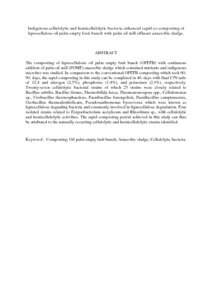Citation
Mohd Zainudin, Mohd Huzairi and Hassan, Mohd Ali and Tokura, Mitsunori and Shirai, Yoshihito
(2013)
Indigenous cellulolytic and hemicellulolytic bacteria enhanced rapid co-composting of lignocellulose oil palm empty fruit bunch with palm oil mill effluent anaerobic sludge.
Bioresource Technology, 147.
pp. 632-635.
ISSN 0960-8524; ESSN: 1873-2976
Abstract
The composting of lignocellulosic oil palm empty fruit bunch (OPEFB) with continuous addition of palm oil mill (POME) anaerobic sludge which contained nutrients and indigenous microbes was studied. In comparison to the conventional OPEFB composting which took 60-90. days, the rapid composting in this study can be completed in 40. days with final C/N ratio of 12.4 and nitrogen (2.5%), phosphorus (1.4%), and potassium (2.8%), respectively. Twenty-seven cellulolytic bacterial strains of which 23 strains were closely related to Bacillus subtilis, Bacillus firmus, Thermobifida fusca, Thermomonospora spp., Cellulomonas sp., Ureibacillus thermosphaericus, Paenibacillus barengoltzii, Paenibacillus campinasensis, Geobacillus thermodenitrificans, Pseudoxanthomonas byssovorax which were known as lignocellulose degrading bacteria and commonly involved in lignocellulose degradation. Four isolated strains related to Exiguobacterium acetylicum and Rhizobium sp., with cellulolytic and hemicellulolytic activities. The rapid composting period achieved in this study can thus be attributed to the naturally occurring cellulolytic and hemicellulolytic strains identified.
Download File
![[img]](http://psasir.upm.edu.my/28130/1.hassmallThumbnailVersion/Indigenous%20cellulolytic%20and%20hemicellulolytic%20bacteria%20enhanced%20rapid%20co.pdf)  Preview |
|
PDF (Abstract)
Indigenous cellulolytic and hemicellulolytic bacteria enhanced rapid co.pdf
Download (83kB)
| Preview
|
|
Additional Metadata
Actions (login required)
 |
View Item |

